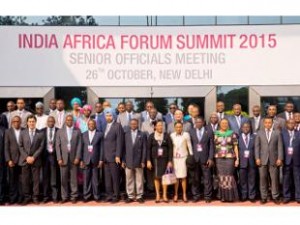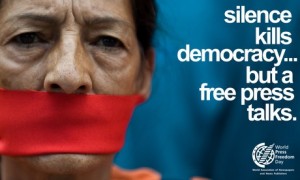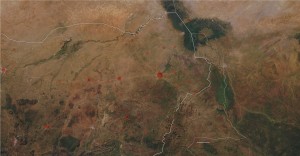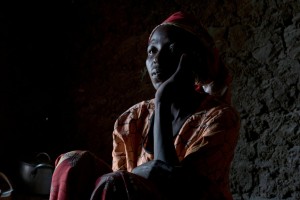Censorship of Media in Africa
Censorship is, according to Merriam-Webster, the suppressing of books, plays, news reports, radio and television programs, motion pictures, letters, etc. that are deemed objectionable on moral, political, military, or other grounds.
When Do Governments Suppress the Media?
There are five different types of suppression governments undertake. (Fischer and Matilde 38)
- Military censorship: involves “acts of sedition […] but also control of public information on airways.” Primarily used to suppress confidential military intelligence and strategies. (Fischer and Matilde 38)
- Political censorship: involves blocking “criticism of regimes in power.” Can also mean the suppression of information from reaching a regime’s citizens as well. (Fischer and Matilde 38)
- Moral censorship: involves “appealing to public decency.” The suppression of morally questionable or obscene forms of media or art. (Fischer and Matilde 38)
- Religious censorship: prevents “certain groups from worshipping in their own way.” Could also be the suppression of ideas not concurrent to the dominant religious belief. (Fischer and Matilde 38)
- Corporate censorship: “uses economic power to protect its interests.” The suppression of information that could prove to be economically detrimental to a company. (Fischer and Matilde 38)
What Counts as Media Suppression?
Any form of censorship of any work or speech is considered media suppression. Censorship can be done by anyone, including governments, private organizations, or even by the creator of the work or speech themselves.
If the creator of the work or speech censors their own work, it is called self-censorship. Self-censorship is typically done when the creator of the work or speech fears the potential punishment or backlash associated with their original piece of work. In Africa, self-censorship seems to be the most common form of restraint. (Zeigler 106) For instance, in South Africa, out of the top 24 newspapers, the only ones that remain in business are the ones who censor themselves sufficiently. (Zeigler 106) This is the sad truth that is pervasive across African countries.
What Kind of Violence is it to Suppress Media?
Violence, according to Merriam-Webster, is “the intentional use of physical force or power, threatened or actual, against oneself, another person, or against a group or community, which either results in or has a high likelihood of resulting in injury, death, psychological harm, maldevelopment, or deprivation.”
While no physical harm is done directly by the suppression of media, the practice certainly falls under the “use of power against oneself, another person, or a group or community which results in deprivation,” aspect of the definition. The deprivation of information is dangerous to a society – without the press, there is no proper check for those with power. Thus, often the systematic suppression of media is done by those in power to keep the normal citizen disadvantaged and keep the rich and powerful – rich and powerful.
Why is Media Important, Specifically in Africa?
The mass media has two main roles in Africa: to speak freely and fearlessly about concrete conditions in their own and other states, and at the same time to be an instrument for informing and mobilizing the people about their rights and obligations. (Martin 334) But, and also as equally important, the African media has a responsibility to the outside world, because typically international news coverage of Africa, with a few noteworthy exceptions, “continue to be little short of abysmal.” (Martin 334).
As the Ghanian UN Secretary General Kofi Annan said when discussing African media during his term, “if information and knowledge and central to democracy, they are conditions for development,” (Olorunnisola 68) and as recognized in the African Charter for Popular Participation in Development, a written charter adopted at the 25th session of the Economic Commission of Africa, which consists of all 54 member states in the continent of Africa, “the national and regional media should make every effort to fight for and defend their freedom at all cost, and generally provide access for the dissemination of information and education programmes on popular participation,” (African Charter for Popular Participation in Development 28) it is evident that there is a stressed importance by the morally sound leaders of Africa to ensure free and open forms of media in order to maintain a fair democracy and represent Africa in a true light. In a continent filled with dictators wishing to suppress fair democracies, the media’s importance must be accentuated.
Debate About Censorship, When is Censorship Applicable?
The question of when censorship is applicable is often up to the discretion of the lawmakers of a country. Societally immoral or unpleasant things are censored on a daily basis, but should a controversial song be censored as immoral or unpleasant?
This is exactly the problem South Africa faced in 2002.
Controversial, but acclaimed, songwriter and playwright Mbongeni Ngema, who has very strong Zulu and African nationalist views, created a song called “AmaNyida.” (Cloonan and Drewitt, 55) He begins the song with a voice-over, spoken in English: “This song represents the way many African people feel about the behavior of Indians in this country. It is intended to begin a constructive discussion that will lead to reconciliation between Indians and Africans.” (Cloonan and Drewitt, 55)
The song goes on to bluntly summarize the grievances many Zulus consider as marginalization and exploitation at the hands of Indian merchants and landlords in the KwaZulu-Natal region, a region in South Africa known for its intolerance. He criticizes Indians as a whole for the following: only voting for white political leaders, refusing to build schools for black children, dispossessing black South Africans, and restricting black South Africans from opening up businesses.
Black South Africans perceived themselves as excluded from jobs in local government because most positions in the Metropolitan Council were filled with Indians. (Cloonan and Drewett, 56) This only perpetuated the perception that all Indians were wealthy and benefited more than Africans from the end of apartheid. While some points Ngema made may have been fair concerns to pose, what really made “AmaNdiya” both audacious and politically incorrect was that he voiced these sentiments openly in spite of the government’s efforts to promote the project of reconciliation and nation building. (Cloonan and Drewett, 56)
A chorus of voices demanded an apology from Ngema for questioning the character of the South African Indian community. (Cloonan and Drewett, 56) If Ngema initially responded to his critics by justifying his song, he was soon pressured away from that idea. (Cloonan and Drewett, 56) Former President Nelson Mandela shamed him, and a pledge to create a debate with the interested parties surrounding the problems and barriers that obstruct the process of reconciliation and nation building was made. (Cloonan and Drewett, 57) A symposium facilitated by the Institute for Democracy in South Africa (IDASA) was held in Durban from June 26-27, 2002. (Cloonan and Drewett, 57) Leaders from both the Indian and black South African communities across all political spectrums gave serious consideration to the song’s claims and to what could be done to defuse the tensions between the two communities. (Cloonan and Drewett, 57) The deliberations on the topic lasted two days, and with much constructive dialogue and frank discussion, Indian and Zulu leaders planned for more open discourse sessions in order to foster reconciliation and open more extensive debates on identity politics in the country. (Cloonan and Drewett, 57)
In light of the leaders’, and the national, debate at hand, the Broadcasting Complaints Commission of South Africa (BCCSA) was then used to determine the legal future of the song. Though section 16(1) of the South African Constitution guaranteed the freedom of artistic creativity, the BCCSA ruled that the song constituted racial hate speech with incitement to harm. (Cloonan and Drewett, 58) Though the debates between Indian and Zulu leaders on identity continued over the following months and years, the BCCSA promptly banned any future airplay of the song after their findings.

African Fight Against Media Suppression
The Windhoek Declaration, released in 1991 by newspaper journalists from throughout the African continent, is one of the most important documents in the struggle for the freedom of the press throughout Africa. The document was presented at a UNESCO seminar in Windhoek, Namibia in 1991, and was later endorsed by the UNESCO General Conference.
Declarations of the document include: “1. Consistent with article 19 of the Universal Declaration of Human Rights, the establishment, maintenance and fostering of an independent, pluralistic and free press is essential to the development and maintenance of democracy in a nation, and for economic development. […]
“7. Today, at least 17 journalists, editors or publishers are in African prisons, and 48 African journalists were killed in the exercise of their profession between 1969 and 1990.
“8. The General Assembly of the United Nations should include in the agenda of its next session an item on the declaration of censorship as a grave violation of human rights falling within the purview of the Commission on Human Rights. […]
“14. As a sign of good faith, African Governments that have jailed journalists for their professional activities should free them immediately. Journalists who have had to leave their countries should be free to return to resume their professional activities.” (Windheok Declaration)

Specific instances of the fight against media suppression in African countries
NIGERIA
From 1993-99, the media of Nigeria deployed a guerilla warfare strategy to topple state censorship and the dictator who ruled for it. This involved a hit-and-run style, where journalists working from hideout spots continued to publish opposition and critical journals in direct defiance of the state. (Olukotun 317)
In the face of detentions, manhunts, assassination attempts, arson attacks on newspaper houses and the disappearance of opposition figures, two weekly journals and a pirate radio station – Tell magazine, The News and Radio Kudirat – demonstrated steady resolve in challenging the state and exposing the vulgarity and corruption of the military custodians of state power. (Olukotun 318) Through the three media outlet’s consistent efforts to reveal the truth, they were able to check the powers of their repressive government.
GHANA
Even during British rule and in the time before it, press freedom was prevalent in Ghana. Only one law during colonial rule, the Criminal Code Ordinance, may have put the freedom of the press at stake, but ultimately it did not change the media landscape of Ghana. (Twumasi 16) No new restrictions were placed on the mass media for the rest of colonial rule.
This continued until the new ruler after independence, Kwame Nkrumah, took measures to nationalize the mass media. By the time of his overthrow in 1966, Nkrumah had eliminated all private news outlets – all media outlets were government owned and operated. (Twumasi 18)
Then, as Kofi Abrefa Busia and the NLC in 1969, the move towards the previous, free system of media was put into place. Busia was dedicated to liberalism as a political thought, but there was also political capital to be gained by his decision – his political base was mostly middle-class professionals. (Twusami 19)
SOMALIA/SOMALILAND
To understand the issue of freedom of the press in Somaliland, one must understand its history with Somalia. Somaliland is currently recognized worldwide as an autonomous region of Somalia, but was once its own colonial region before merging with Somalia for their mutual independences in 1961. (Hohne 94)
After a coup d’état in 1969, Major General Mohamed Siad Barre rose to power, and ruled for 21 years. His rule, however, eroded morally over time. (Hohne 95) Barre started to commit major human rights violations and abused his power heavily in his quest to stay President, but was unable to completely eliminate freedom of speech. (Hohne 107)
After his dictatorial reign was toppled, privately owned print media was established immediately all over Somalia and flourished – first as “wild flowers,” then in a more cultivated manner. (Hohne 107) Particularly in Somaliland, which seceded from the rest of Somalia in 1991, the press had developed a governmentally-critical role that was healthy for both the citizens and the government. (Hohne 108) The press, more specifically newspapers, have aided in the democratization of both Somaliland and Somalia as a result. (Hohne 91)
Recent events concerning the newspaper scene, such as the passage of a press law in early 2004 and the subsequent attempts of the government to repress all overly free journalism, can be interpreted as part of the struggle to find the balance between freedom of the press and restriction of the press that is the basis of liberal democracy. (Hohne 108)
Present Day
Ironically enough, as mentioned above, the suppression of media did not become a pervading issue until countries began to gain independence. During colonial rule, while media was suppressed in certain instances, mass media was not entirely nationalized like in Ghana or Nigeria.
Like most complex sociopolitical issues, it takes years and years to properly, and systematically, change issues that involve almost every facet of society. Mass media is consumed by all in a society, except for a small, minuscule amount of people. Achieving full and sustainable democratic potential in Africa depends upon widening and deepening the institutions of voice and accountability, which still generally remain weak and deeply flawed. (Fombad 650) As indicated by the growing democratization of the continent, and documents like the Windhoek Declaration and the African Charter for Popular Participation in Development, it is evident that freedom of the press is continually increasing throughout the continent. That trend seems destined to continue to rise, and let’s hope that it does. As globalization takes hold of the world and communication becomes more and more readily accessible in Africa, it will get harder and harder for the dictatorial regimes of Africa to efficiently suppress information from their subjects.
Works Cited
Cloonan, Martin, and Michael Drewett. Popular Music Censorship in Africa. Farnham: Ashgate Publishing, 2013. www.jstor.com Accessed May 1
Fischer, Beatrice, and Matilde N. Jensen. Title Translation and the Reconfiguration of Power Relations: Revisiting Role and Context of Translation and Interpreting. Münster: LIT Verlag Münster, 2012. www.jstor.com Accessed April 30
Fombad, C.M. (2002). The Protection of Freedom of Expression in the Public Service Media in Southern Africa: A Botswana Perspective. Modern Law Review, 65(5), 649-675.(“Woodruff”) Accessed April 28
Hohne, Markus. (2008). Newspapers in Hargeysa: Freedom of Speech in Post-Conflict Somaliland. Africa Spectrum, 43(1), 91-113. Hamburg: Institute of African Affairs at GIGA. www.jstor.com Accessed May 1
Martin, R. (1992). Building Independent Mass Media in Africa. The Journal of Modern African Studies J. Mod. Afr. Stud., 30(02), 331-356. Cambridge: Cambridge University Press. (“Woodruff”) Accessed April 28
Olorunnisola, Anthony A. New Media Influence on Social and Political Change in Africa. Hershey: IGI Global, 2013. books.google.com Accessed April 30
Olukotun, A. (2002). Authoritarian State, Crisis of Democratization and the Underground Media in Nigeria. African Affairs, 101(404), 317-342. London: Oxford University Press.(“Woodruff”) Accessed April 27
Twumasi, Yaw. (1981). Media of Mass Communication and the Third Republican Constitution of Ghana. African Affairs, 80(318), 16-41. London: Oxford University Press.(“Woodruff”) Accessed April 28
United Nations Economic Commission for Africa. African Charter for Popular Participation in Development. Addis Ababa, Ethiopia: United Nations Economic Commission for Africa, 1990. http://www.ircwash.org/resources/african-charter-popular-participation-development-and-transformation-arusha-1990 Accessed May 1
United Nations Nations Department of Peacekeeping Operations. The Windhoek Declaration: Promoting an Independent and Pluralistic African Press. Windhoek, Namibia: United Nations Department of Peacekeeping Operations, 1991. http://www.unesco.org/webworld/fed/temp/communication_democracy/windhoek.htm Accessed 30 April 2016

